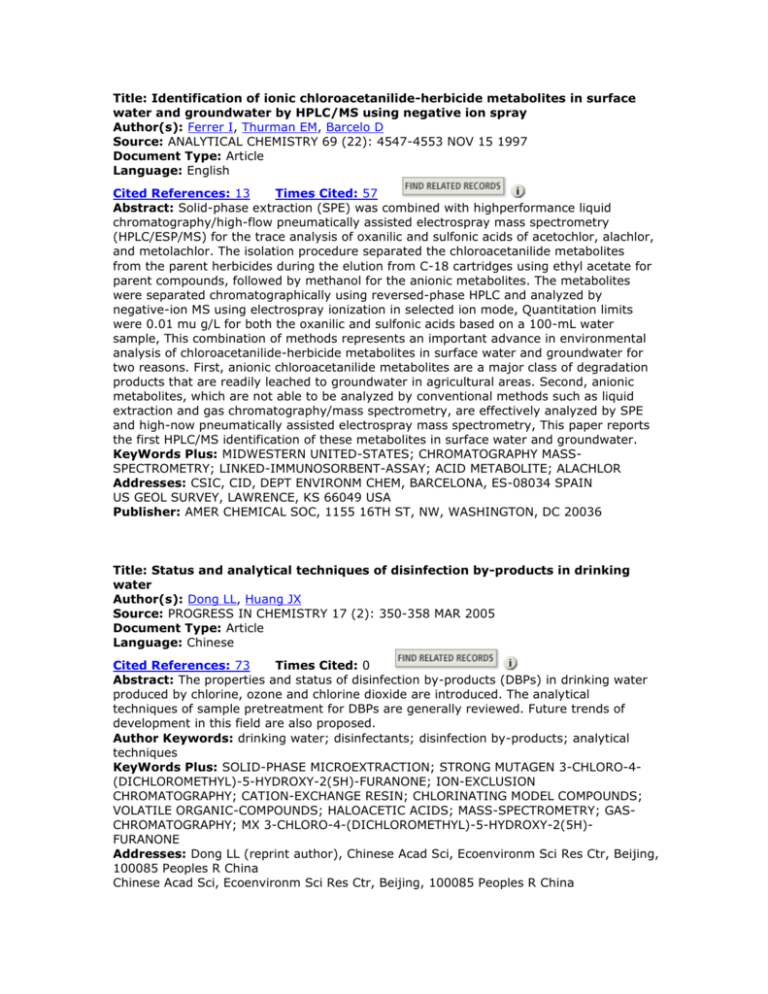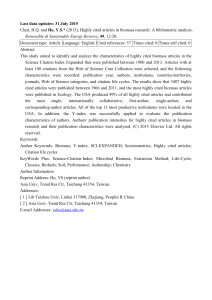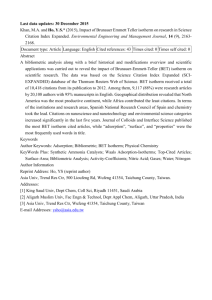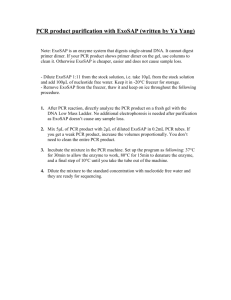
Title: Identification of ionic chloroacetanilide-herbicide metabolites in surface
water and groundwater by HPLC/MS using negative ion spray
Author(s): Ferrer I, Thurman EM, Barcelo D
Source: ANALYTICAL CHEMISTRY 69 (22): 4547-4553 NOV 15 1997
Document Type: Article
Language: English
Cited References: 13
Times Cited: 57
Abstract: Solid-phase extraction (SPE) was combined with highperformance liquid
chromatography/high-flow pneumatically assisted electrospray mass spectrometry
(HPLC/ESP/MS) for the trace analysis of oxanilic and sulfonic acids of acetochlor, alachlor,
and metolachlor. The isolation procedure separated the chloroacetanilide metabolites
from the parent herbicides during the elution from C-18 cartridges using ethyl acetate for
parent compounds, followed by methanol for the anionic metabolites. The metabolites
were separated chromatographically using reversed-phase HPLC and analyzed by
negative-ion MS using electrospray ionization in selected ion mode, Quantitation limits
were 0.01 mu g/L for both the oxanilic and sulfonic acids based on a 100-mL water
sample, This combination of methods represents an important advance in environmental
analysis of chloroacetanilide-herbicide metabolites in surface water and groundwater for
two reasons. First, anionic chloroacetanilide metabolites are a major class of degradation
products that are readily leached to groundwater in agricultural areas. Second, anionic
metabolites, which are not able to be analyzed by conventional methods such as liquid
extraction and gas chromatography/mass spectrometry, are effectively analyzed by SPE
and high-now pneumatically assisted electrospray mass spectrometry, This paper reports
the first HPLC/MS identification of these metabolites in surface water and groundwater.
KeyWords Plus: MIDWESTERN UNITED-STATES; CHROMATOGRAPHY MASSSPECTROMETRY; LINKED-IMMUNOSORBENT-ASSAY; ACID METABOLITE; ALACHLOR
Addresses: CSIC, CID, DEPT ENVIRONM CHEM, BARCELONA, ES-08034 SPAIN
US GEOL SURVEY, LAWRENCE, KS 66049 USA
Publisher: AMER CHEMICAL SOC, 1155 16TH ST, NW, WASHINGTON, DC 20036
Title: Status and analytical techniques of disinfection by-products in drinking
water
Author(s): Dong LL, Huang JX
Source: PROGRESS IN CHEMISTRY 17 (2): 350-358 MAR 2005
Document Type: Article
Language: Chinese
Cited References: 73
Times Cited: 0
Abstract: The properties and status of disinfection by-products (DBPs) in drinking water
produced by chlorine, ozone and chlorine dioxide are introduced. The analytical
techniques of sample pretreatment for DBPs are generally reviewed. Future trends of
development in this field are also proposed.
Author Keywords: drinking water; disinfectants; disinfection by-products; analytical
techniques
KeyWords Plus: SOLID-PHASE MICROEXTRACTION; STRONG MUTAGEN 3-CHLORO-4(DICHLOROMETHYL)-5-HYDROXY-2(5H)-FURANONE; ION-EXCLUSION
CHROMATOGRAPHY; CATION-EXCHANGE RESIN; CHLORINATING MODEL COMPOUNDS;
VOLATILE ORGANIC-COMPOUNDS; HALOACETIC ACIDS; MASS-SPECTROMETRY; GASCHROMATOGRAPHY; MX 3-CHLORO-4-(DICHLOROMETHYL)-5-HYDROXY-2(5H)FURANONE
Addresses: Dong LL (reprint author), Chinese Acad Sci, Ecoenvironm Sci Res Ctr, Beijing,
100085 Peoples R China
Chinese Acad Sci, Ecoenvironm Sci Res Ctr, Beijing, 100085 Peoples R China
E-mail Addresses: junxionghuang@yahoo.com
Publisher: CHINESE ACAD SCIENCES, NO. 8 KEXUEYUANNANLU, ZHONGGUANCUN,
BEIJING 100080, PEOPLES R CHINA
Subject Category: CHEMISTRY, MULTIDISCIPLINARY
IDS Number: 912JH
Title: Using ion chromatography to monitor haloacetic acids in drinking water: a
review of current technologies
Author(s): Paull B, Barron L
Source: JOURNAL OF CHROMATOGRAPHY A 1046 (1-2): 1-9 AUG 13 2004
Document Type: Review
Language: English
Cited References: 37
Times Cited: 2
Abstract: A review of the application of ion chromatography to the determination of
haloacetic acids in drinking water is given. As it requires no sample derivatisation, ion
chromatography in its various modes, such as ion-exchange, ion-interaction and ionexclusion chromatography, is increasingly being investigated as a simpler alternative to
gas chromatographic methods for the determination of polar disinfection by-products
(DBPs) in drinking waters. Detection limits quoted for the regulated haloacetic acids
(HAA5), are commonly in the mid to low mug/L range, however, in most cases analyte
preconcentration is still necessary for detection at concentrations commonly found in
actual drinking water samples. The coupling of ion chromatography to electrospray mass
spectrometry provides a potential future direction, with improved sensitivity and
selectivity compared to conductivity based detection, however associated cost and
complexity for routine analysis is currently relatively high. (C) 2004 Elsevier B.V. All
rights reserved.
Author Keywords: reviews; water analysis; haloacetic acids
KeyWords Plus: CATION-EXCHANGE RESIN; MASS-SPECTROMETRIC DETECTION;
DISINFECTION BY-PRODUCTS; EXCLUSION CHROMATOGRAPHY; CARBOXYLIC-ACIDS;
CHLORINATION; TRIHALOMETHANES; HAAS; THMS
Addresses: Paull B (reprint author), Dublin City Univ, Natl Ctr Sensor Res, Sch Chem Sci,
Dublin, 9 Ireland
Dublin City Univ, Natl Ctr Sensor Res, Sch Chem Sci, Dublin, 9 Ireland
E-mail Addresses: brett.paull@dcu.ie
Publisher: ELSEVIER SCIENCE BV, PO BOX 211, 1000 AE AMSTERDAM, NETHERLANDS
Subject Category: CHEMISTRY, ANALYTICAL; BIOCHEMICAL RESEARCH METHODS
IDS Number: 847AP
Title: Characterizing dissolved organic carbon using asymmetrical flow fieldflow fractionation with on-line UV and DOC detection
Author(s): Reszat TN, Hendry MJ
Source: ANALYTICAL CHEMISTRY 77 (13): 4194-4200 JUL 1 2005
Document Type: Article
Language: English
Cited References: 41
Times Cited: 0
Abstract: A method of characterizing dissolved organic carbon (DOC) by asymmetrical
flow field-flow fractionation with on-line UV and DOC detection is described and applied to
standards and natural water samples. Poly(styrenesulfonate) polymer standards,
Suwannee River humic standards, and naturally occurring surface water and groundwater
DOC were analyzed using this coupled detection technique. Molecular weight
determinations in the samples and standards were 6-30% lower with DOC analysis than
UV analysis. This difference was attributed to the insensitivity of the latter technique to
nonaromatic carbon and suggests the molecular weight determined with the DOC
detector is a more accurate representation of the actual molecular weight of the DOC. A
normalized intensity comparison (NIC) method was proposed to distinguish differences in
the relative amounts of aromatic and aliphatic carbon in DOC by comparing the two
detector responses. The NIC method was applied to yield an average aromatic content of
the bulk DOC and to detail the aromatic content over a range of molecular weights in a
single DOC fraction.
KeyWords Plus: MOLECULAR-WEIGHT DISTRIBUTIONS; SIZE-EXCLUSION
CHROMATOGRAPHY; CLAY-RICH AQUITARD; HUMIC SUBSTANCES; FULVIC-ACIDS; PORE
WATERS; MATTER; OPTIMIZATION; COLLOIDS; AQUIFER
Addresses: Reszat TN (reprint author), Univ Saskatchewan, Dept Geol Sci, Saskatoon,
SK S7N 5E2 Canada
Univ Saskatchewan, Dept Geol Sci, Saskatoon, SK S7N 5E2 Canada
E-mail Addresses: thr690@mail.usask.ca
Publisher: AMER CHEMICAL SOC, 1155 16TH ST, NW, WASHINGTON, DC 20036 USA
Subject Category: CHEMISTRY, ANALYTICAL
Title: Review of analytical methods for the determination of nonylphenol and
related compounds in environmental samples
Author(s): Lee HB
Source: WATER QUALITY RESEARCH JOURNAL OF CANADA 34 (1): 3-35 1999
Document Type: Review
Language: English
Cited References: 97
Times Cited: 41
Abstract: Analytical methods published in the last 20 years for the extraction,
chromatographic separation, and quantification of alkylphenol ethoxylates (APEO) and
related compounds in environmental samples are reviewed. Examples of various isolation
and preconcentration techniques for water, effluent, sediment and sludge are presented.
This includes procedures from the classical liquid-liquid and Soxhlet extraction to the upto-date solid phase and supercritical fluid extraction. Chromatographic separation of
APEO by normal and reversed phase liquid chromatography (LC) and capillary column gas
chromatography (GC) is compared. A variety of quantification methods involving the
common LC and GC detectors as well as various mass spectrometric techniques are also
discussed.
Author Keywords: nonylphenol ethoxylates; nonylphenol; octylphenol; determination;
environmental samples
KeyWords Plus: PERFORMANCE LIQUID-CHROMATOGRAPHY; ALKYLPHENOL
POLYETHOXYLATE SURFACTANTS; PERSISTENT ORGANIC-CHEMICALS; CAPILLARY GASCHROMATOGRAPHY; SUPERCRITICAL-FLUID CHROMATOGRAPHY; MASSSPECTROMETRIC ANALYSIS; SOLID-PHASE EXTRACTION; NON-IONIC SURFACTANTS;
NONIONIC SURFACTANTS; LINEAR ALKYLBENZENESULFONATES
Addresses: Lee HB (reprint author), Environm Canada, Canada Ctr Inland Waters, Aquat
Ecosyst Protect Branch, 867 Lakeshore Rd, Burlington, ON L7R 4A6 Canada
Environm Canada, Canada Ctr Inland Waters, Aquat Ecosyst Protect Branch, Burlington,
ON L7R 4A6 Canada
Publisher: CANADIAN ASSOC WATER QUALITY, C/O DR H R EISENHAUER,
ENVIRONMENTAL TECHNOL CENTRE, 3439 RIVER ROAD SOUTH, GLOUCESTER, ONTARIO
K1A 0H3, CANADA
Subject Category: WATER RESOURCES
Title: Identification of organic residues in tertiary effluents by GC/EI-MS,
GC/CI-MS and GC/TSQ-MS
Author(s): Ding WH, Fujita Y, Aeschimann R, Reinhard M
Source: FRESENIUS JOURNAL OF ANALYTICAL CHEMISTRY 354 (1): 48-55 JAN 1996
Document Type: Article
Language: English
Cited References: 24
Times Cited: 30
Abstract: A method was developed for the analysis of non-volatile dissolved organic
residues in tertiary treated wastewater effluents. This method involved concentration of
samples by rotary evaporation, propylation using propanol/formic acid/acetyl chloride,
and separation, detection and quantitation by capillary GC/EI and CI-MS and GC/TSQ-MS
analysis. Ethylenediamine tetraacetic acid (EDTA) was the most prominent compound
found in both granular activated carbon (GAG) and chlorinated GAC effluents (110 and
140 mu g/L, respectively). Other compounds identified included nitrilotriacetic acid (NTA),
carboxyalkylphenoxy ethoxy carboxylates, poly(propoxy), poly(ethoxy) or
poly(ethoxy)(propoxy) compounds, small aliphatic dicarboxylic acids and aldehydes, all at
mu g/L levels. Approximately 80% of all chromatographically separated compounds were
positively or tentatively identified. The identified compounds are estimated to account for
approximately 10% of the dissolved organic carbon.
KeyWords Plus: CHROMATOGRAPHY MASS-SPECTROMETRY; RESOLUTION GASCHROMATOGRAPHY; ACID; WATER
Addresses: Ding WH (reprint author), STANFORD UNIV, DEPT CIVIL ENGN, STANFORD,
CA 94305 USA
ETH ZURICH, ORGAN CHEM ABT, ZURICH, SWITZERLAND
Publisher: SPRINGER VERLAG, 175 FIFTH AVE, NEW YORK, NY 10010
Subject Category: CHEMISTRY, ANALYTICAL
IDS Number: TN471
Title: Analysis of nonylphenol polyethoxylates and their degradation products in
river water and sewage effluent by gas chromatography ion trap (tandem) mass
spectrometry with electron impact and chemical ionization
Author(s): Ding WH, Tzing SH
Source: JOURNAL OF CHROMATOGRAPHY A 824 (1): 79-90 OCT 16 1998
Document Type: Article
Language: English
Cited References: 26
Times Cited: 44
Abstract: A method is presented for the analysis of nonylphenol polyethoxylate (NPEO)
residues and their degradation products, nonylphenol polyethoxy carboxylates and
carboxyalkylphenol ethoxy carboxylates, in the samples of river water and sewage
effluent. The method involves extraction of the samples by graphitized carbon black (GCB)
cartridge, propylation by a propanol/acetyl chloride derivatization procedure, and
separation, identification and quantitation by ion-trap GC-MS with electron impact
ionization (EI), liquid-chemical ionization (CI) and CI-MS-MS modes. The large-volume
injection technique provides high precision and sensitivity for both NPEO residues and
their degradation products, to quantitation at greater than or equal to 0.01 mu g/l in 100
ml of water samples. Dicarboxylic acids of NPEO residues were identified by the CI-MSMS technique with relatively high concentrations in the samples of river water and
sewage effluent. Recovery of nonylphenol and octylphenoxyacetic acid in spiked water
samples ranged from 81 to 107%. Relative standard deviations of replicate analyses
ranged from 2 to 12%. (C) 1998 Elsevier Science B.V. All rights reserved.
Author Keywords: water analysis; sewage effluent; environmental analysis;
nonylphenol polyethoxylates; polyethoxylates; surfactants
KeyWords Plus: NONIONIC SURFACTANTS; AQUATIC ENVIRONMENT; ALKYLPHENOL;
TRANSFORMATION; IDENTIFICATION; CARBOXYLATES; BEHAVIOR; RESIDUES; SPECTRA;
MS
Addresses: Ding WH (reprint author), Natl Cent Univ, Dept Chem, Chungli, 32054
Taiwan
Natl Cent Univ, Dept Chem, Chungli, 32054 Taiwan
Publisher: ELSEVIER SCIENCE BV, PO BOX 211, 1000 AE AMSTERDAM, NETHERLANDS
Subject Category: CHEMISTRY, ANALYTICAL; BIOCHEMICAL RESEARCH METHODS
IDS Number: 133PM
Title: Identification of metabolites from the biological transformation of the
nonionic surfactant residue octylphenoxyacetic acid and its brominated analog
Author(s): Fujita Y, Reinhard M
Source: ENVIRONMENTAL SCIENCE & TECHNOLOGY 31 (5): 1518-1524 MAY 1997
Document Type: Article
Language: English
Cited References: 44
Times Cited: 22
Abstract: The aerobic biological transformation of octylphenoxyacetic acid (OP1EC) and
its brominated analog (BrOP1EC) by groundwater enrichment cultures was studied, and
persistent metabolites were identified by GC/MS. OP1EC is a representative of the class
of alkylphenol ethoxycarboxylates (APEC), formed from alkylphenol polyethoxylate
nonionic surfactants during sewage treatment. BrOP1EC is a byproduct formed during
chlorine disinfection in the presence of bromide. The metabolite 2,4,4-trimethyl-2pentanol was detected in stoichiometric quantities in OP1EC-metabolizing enrichment
cultures, representing the intact alkyl side chain as a tertiary alcohol. BrOP1EC was
transformed by the OP1EC-utilizing cultures only if OP1EC was simultaneously
metabolized, suggesting a cometabolic mechanism of transformation. Brominated
intermediates were also detected: brominated octylphenol and a compound tentatively
identified as 2-aminomethoxy-3-bromo-5-(1,1,3,3-tetramethylbutyl)phenol.
KeyWords Plus: ALKYLPHENOL POLYETHOXYLATE SURFACTANTS; LIQUIDCHROMATOGRAPHY; MASS-SPECTROMETRY; AQUATIC ENVIRONMENT; SEWAGETREATMENT; TREATMENT PLANT; NONYL-PHENOL; ETHOXYLATES; WATER;
BIODEGRADABILITY
Addresses: STANFORD UNIV, DEPT CIVIL ENGN, STANFORD, CA 94305 USA
Publisher: AMER CHEMICAL SOC, 1155 16TH ST, NW, WASHINGTON, DC 20036
Subject Category: ENGINEERING, ENVIRONMENTAL; ENVIRONMENTAL SCIENCES
IDS Number: WW948
ISSN: 0013-936X
The below papers are examples of PCR
methods applied to detect Viruses in
Environmental Waters
Title: Sensor components for PCR detection of Salmonella in alfalfa sprout
irrigation water
Author(s): Jackson E, Delwiche M, Barak J, Charkowski A, Suslow T
Source: TRANSACTIONS OF THE ASAE 47 (6): 2137-2144 NOV-DEC 2004
Document Type: Article
Language: English
Cited References: 22
Times Cited: 0
Abstract: Salmonella has been associated with a number of recent outbreaks of
foodborne illness involving sprouted seeds. In this research, we addressed the design of
sensor components intended for use in a fully automated detection system. A real-time
PCR assay was developed to detect Salmonella in sprout irrigation water. Specific
detection was achieved by targeting a region of the invasion gene, invA. The detection
limit for Salmonella in sterile water was approximately 400 CFU, and in sprout irrigation
water the detection limit was approximately 200 CFU. Components for an automated
sensing system were designed, including a thermal cycler and a fluorescent optical sensor
The thermal cycler utilized a thermoelectric module for heating and cooling the sample
block and a heat sink and fan to remove heat from the module during cooling. Sample
temperature was controlled to within about 1degreesC at each of the PCR setpoints
(94degreesC, 55degreesC, and 72degreesC). The optical sensor used a laser diode (635
nm) for excitation and a bandpass interference filter (700 +/- 20 nm) coupled with a
photodiode for fluorescence detection. The DNA dye TO-PRO-3 (642 nm excitation; 661
nm emission) was chosen to match the excitation wavelength of the laser diode.
Calibration of the optical sensor with calf thymus DNA showed detection down to 0.01
mug mL(-1), demonstrating the potential to detect down to 1 CFU if used in conjunction
with PCR. When the sensor components were used to implement the real-time assay, S.
Newport was detected to approximately 7.3 x 10(4) CFU in sterile water and
approximately 1.5 x 10(6) CFU in sprout irrigation water. Further optimization of the
assay in the sensor will be needed to improve the detection limits.
Author Keywords: biosensor food safety; pathogens; real-time PCR
KeyWords Plus: POLYMERASE-CHAIN-REACTION; ESCHERICHIA-COLI O157-H7;
BIOSENSOR; BACTERIA; AMPLIFICATION; SAMPLES; ASSAY
Addresses: Delwiche M (reprint author), Univ Calif Davis, Dept Biol & Agr Engn, 1 Shield
Ave, Davis, CA 95616 USA
Univ Calif Davis, Dept Biol & Agr Engn, Davis, CA 95616 USA
USDA ARS, Western Reg Res Ctr, Albany, CA 94710 USA
Univ Wisconsin, Dept Plant Pathol, Madison, WI 53706 USA
Univ Calif Davis, Dept Veg Crops, Davis, CA 95616 USA
E-mail Addresses: mjdelwiche@ucdavis.edu
Publisher: AMER SOC AGRICULTURAL ENGINEERS, 2950 NILES RD, ST JOSEPH, MI
49085-9659 USA
Subject Category: AGRICULTURAL ENGINEERING
PDF File of Paper Found?
Review Notes
Title: An efficient virus concentration method and RT-nested PCR for detection
of rotaviruses in environmental water samples
Author(s): Kittigul L, Ekchaloemkiet S, Utrarachkij F, Siripanichgon K, Sujirarat D,
Pungchitton S, Boonthum A
Source: JOURNAL OF VIROLOGICAL METHODS 124 (1-2): 117-122 MAR 2005
Document Type: Article
Language: English
Cited References: 27
Times Cited: 0
Abstract: Water samples were concentrated by the modified adsorption-elution
technique followed by speedVac reconcentration of the filter eluates. Reverse
transcriptase-nested polymerase chain reaction (RT-nested PCR) was used to detect
rotavirus RNA in concentrates of the water. The detection limit of the rotavirus
determined by RT-nested PCR alone was about 1.67 plaque forming units (PFU) per RTPCR assay and that by RT-nested PCR combined with concentration from I I seeded tap
water sample was 1.46 plaque forming units per assay. Water samples were collected
from various sources, concentrated, and determined rotavirus RNA. Of 120 water
samples, rotavirus RNA was detected in 20 samples (16.7%); 2/10 (20%) of the river
samples, 8/30 (26.7%) of the canal samples, and 10/40 (25%) of the sewage samples
but was not found in any tap water samples (0/40). Only three water samples were
positive for rotavirus antigen determined using an enzyme-linked immunosorbent assay
(ELISA). Alignment analysis of the sequenced PCR product (346-bp fragment) was
performed in eight rotavirus-positive samples using the rotavirus sequence deposited in
the GenBank. All samples gave the correct VP7 sequence. Results of analysis showed two
samples similar to human rotavirus (97-98%), five similar to rotavirus G9 sequence (9499%), and one sample similar to animal rotavirus (97%). PCR inhibitors were not
observed in any concentrated water samples. In all 20 (of 120) samples where
rotaviruses were found, fecal coliforms including Escherichia coli were also found, but of
the samples testing negative for rotaviruses, 76 were fecal coliforms positive and 69 were
E. coli positive. The combination of the virus concentration method and RT-nested PCR
described below made it possible to effectively detect rotaviruses in environmental water
samples. (C) 2004 Elsevier B.V. All rights reserved.
Author Keywords: virus concentration method; RT-nested PCR; rotaviruses; water
samples
KeyWords Plus: POLYMERASE-CHAIN-REACTION; REVERSE TRANSCRIPTION;
DRINKING-WATER; SEWAGE; ENTEROVIRUSES; GROUNDWATER; SURVIVAL;
GASTROENTERITIS; INHIBITORS; OUTBREAK
Addresses: Kittigul L (reprint author), Mahidol Univ, Fac Publ Hlth, Dept Microbiol, 420-1
Rajvithi Rd, Bangkok, 10400 Thailand
Mahidol Univ, Fac Publ Hlth, Dept Microbiol, Bangkok, 10400 Thailand
Mahidol Univ, Fac Publ Hlth, Dept Epidemiol, Bangkok, 10400 Thailand
Mahidol Univ, Fac Publ Hlth, Rural Hlth Training & Res Ctr, Bangkok, 10400 Thailand
E-mail Addresses: phlkt@mahidol.ac.th
PDF File of Paper Found?
Review Notes
Title: A strategy for detection of viruses in groundwater by PCR
Author(s): Abbaszadegan M, Stewart P, LeChevallier M
Source: APPLIED AND ENVIRONMENTAL MICROBIOLOGY 65 (2): 444-449 FEB 1999
Document Type: Article
Language: English Cited References: 15
Times Cited: 42
Abstract: We evaluated the use of the PCR for detection of enteric viruses in
groundwater. To do this, we used an improved sample-processing technique and a largevolume amplification protocol. The objective of this study was to use advanced molecular
techniques to develop a rapid and simple method which can be used by the water
industry for detection of viral contamination in a variety of water samples. The strategy
described here fulfills the water industry's need for a rapid, reliable, easily performed
method for analyzing groundwater for virus contamination. Viruses were detected after
concentration from at least 400 gallons (1,512 liters) of water by a filter adsorption and
elution method, which resulted in a concentrate containing viruses. A total of 150
samples were analyzed by performing cell culture assays for enteroviruses and by
performing reverse transcription PCR (RT-PCR) analyses for enteroviruses, hepatitis A
virus, and rotavirus. Thirteen samples (8.7%) produced cellular cytopathic effects when
the Buffalo green monkey cell line was used. When primers specific for enteroviruses
were used in RT-PCR, 40 of 133 samples (30.1%) tested positive for the presence of
enterovirus RNA. When hepatitis A virus-specific primers were used, 12 of 139 samples
(8.6%) were considered positive for the presence of hepatitis A viral RNA. The RT-PCR
analysis performed with rotavirus-specific primers identified 18 of 130 samples (13.8%)
that were positive for rotavirus RNA sequences. Our sample-procesing technique and
large-volume PCR protocol (reaction volume, 300 mu l) resulted in sufficient removal or
dilution of inhibitors so that more than 95% of the samples could be assayed by PCR,
Because of its sensitivity for detecting viral nucleic acid sequences, PCR analysis should
produce more positive results than cell culture analysis. Since either cell culture analysis
or PCR can reveal only a ''snapshot" of the quality of the groundwater being sampled,
PCR seems to be a desirable rapid initial screening tool.
KeyWords Plus: POLYMERASE CHAIN-REACTION; ENTERIC VIRUSES; DRINKINGWATER; DNA; ENTEROVIRUSES; AMPLIFICATION
Addresses: Abbaszadegan M (reprint author), Amer Water Works Serv Co Inc, Qual
Control & Res Lab, 1115 S Illinois St, Belleville, IL 62220 USA
Amer Water Works Serv Co Inc, Qual Control & Res Lab, Belleville, IL 62220 USA
Amer Water Works Co Inc, Voorhees, NJ 08043 USA
Publisher: AMER SOC MICROBIOLOGY, 1325 MASSACHUSETTS AVENUE, NW,
WASHINGTON, DC 20005-4171 USA
Subject Category: BIOTECHNOLOGY & APPLIED MICROBIOLOGY; MICROBIOLOGY
IDS Number: 165AC
PDF File of Paper Found?
Review Notes
Title: An efficient virus concentration method and RT-nested PCR for detection
of rotaviruses in environmental water samples
Author(s): Kittigul L, Ekchaloemkiet S, Utrarachkij F, Siripanichgon K, Sujirarat D,
Pungchitton S, Boonthum A
Source: JOURNAL OF VIROLOGICAL METHODS 124 (1-2): 117-122 MAR 2005
Document Type: Article
Language: English
Cited References: 27
Times Cited: 0
Abstract: Water samples were concentrated by the modified adsorption-elution
technique followed by speedVac reconcentration of the filter eluates. Reverse
transcriptase-nested polymerase chain reaction (RT-nested PCR) was used to detect
rotavirus RNA in concentrates of the water. The detection limit of the rotavirus
determined by RT-nested PCR alone was about 1.67 plaque forming units (PFU) per RTPCR assay and that by RT-nested PCR combined with concentration from I I seeded tap
water sample was 1.46 plaque forming units per assay. Water samples were collected
from various sources, concentrated, and determined rotavirus RNA. Of 120 water
samples, rotavirus RNA was detected in 20 samples (16.7%); 2/10 (20%) of the river
samples, 8/30 (26.7%) of the canal samples, and 10/40 (25%) of the sewage samples
but was not found in any tap water samples (0/40). Only three water samples were
positive for rotavirus antigen determined using an enzyme-linked immunosorbent assay
(ELISA). Alignment analysis of the sequenced PCR product (346-bp fragment) was
performed in eight rotavirus-positive samples using the rotavirus sequence deposited in
the GenBank. All samples gave the correct VP7 sequence. Results of analysis showed two
samples similar to human rotavirus (97-98%), five similar to rotavirus G9 sequence (9499%), and one sample similar to animal rotavirus (97%). PCR inhibitors were not
observed in any concentrated water samples. In all 20 (of 120) samples where
rotaviruses were found, fecal coliforms including Escherichia coli were also found, but of
the samples testing negative for rotaviruses, 76 were fecal coliforms positive and 69 were
E. coli positive. The combination of the virus concentration method and RT-nested PCR
described below made it possible to effectively detect rotaviruses in environmental water
samples. (C) 2004 Elsevier B.V. All rights reserved.
Author Keywords: virus concentration method; RT-nested PCR; rotaviruses; water
samples
KeyWords Plus: POLYMERASE-CHAIN-REACTION; REVERSE TRANSCRIPTION;
DRINKING-WATER; SEWAGE; ENTEROVIRUSES; GROUNDWATER; SURVIVAL;
GASTROENTERITIS; INHIBITORS; OUTBREAK
Addresses: Kittigul L (reprint author), Mahidol Univ, Fac Publ Hlth, Dept Microbiol, 420-1
Rajvithi Rd, Bangkok, 10400 Thailand
Mahidol Univ, Fac Publ Hlth, Dept Microbiol, Bangkok, 10400 Thailand
Mahidol Univ, Fac Publ Hlth, Dept Epidemiol, Bangkok, 10400 Thailand
Mahidol Univ, Fac Publ Hlth, Rural Hlth Training & Res Ctr, Bangkok, 10400 Thailand
E-mail Addresses: phlkt@mahidol.ac.th
PDF File of Paper Found?
Review Notes
Title: Sensor components for PCR detection of Salmonella in alfalfa sprout
irrigation water
Author(s): Jackson E, Delwiche M, Barak J, Charkowski A, Suslow T
Source: TRANSACTIONS OF THE ASAE 47 (6): 2137-2144 NOV-DEC 2004
Document Type: Article
Language: English
Cited References: 22
Times Cited: 0
Abstract: Salmonella has been associated with a number of recent outbreaks of
foodborne illness involving sprouted seeds. In this research, we addressed the design of
sensor components intended for use in a fully automated detection system. A real-time
PCR assay was developed to detect Salmonella in sprout irrigation water. Specific
detection was achieved by targeting a region of the invasion gene, invA. The detection
limit for Salmonella in sterile water was approximately 400 CFU, and in sprout irrigation
water the detection limit was approximately 200 CFU. Components for an automated
sensing system were designed, including a thermal cycler and a fluorescent optical sensor
The thermal cycler utilized a thermoelectric module for heating and cooling the sample
block and a heat sink and fan to remove heat from the module during cooling. Sample
temperature was controlled to within about 1degreesC at each of the PCR setpoints
(94degreesC, 55degreesC, and 72degreesC). The optical sensor used a laser diode (635
nm) for excitation and a bandpass interference filter (700 +/- 20 nm) coupled with a
photodiode for fluorescence detection. The DNA dye TO-PRO-3 (642 nm excitation; 661
nm emission) was chosen to match the excitation wavelength of the laser diode.
Calibration of the optical sensor with calf thymus DNA showed detection down to 0.01
mug mL(-1), demonstrating the potential to detect down to 1 CFU if used in conjunction
with PCR. When the sensor components were used to implement the real-time assay, S.
Newport was detected to approximately 7.3 x 10(4) CFU in sterile water and
approximately 1.5 x 10(6) CFU in sprout irrigation water. Further optimization of the
assay in the sensor will be needed to improve the detection limits.
Author Keywords: biosensor food safety; pathogens; real-time PCR
KeyWords Plus: POLYMERASE-CHAIN-REACTION; ESCHERICHIA-COLI O157-H7;
BIOSENSOR; BACTERIA; AMPLIFICATION; SAMPLES; ASSAY
Addresses: Delwiche M (reprint author), Univ Calif Davis, Dept Biol & Agr Engn, 1 Shield
Ave, Davis, CA 95616 USA
Univ Calif Davis, Dept Biol & Agr Engn, Davis, CA 95616 USA
USDA ARS, Western Reg Res Ctr, Albany, CA 94710 USA
Univ Wisconsin, Dept Plant Pathol, Madison, WI 53706 USA
Univ Calif Davis, Dept Veg Crops, Davis, CA 95616 USA
E-mail Addresses: mjdelwiche@ucdavis.edu
Publisher: AMER SOC AGRICULTURAL ENGINEERS, 2950 NILES RD, ST JOSEPH, MI
49085-9659 USA
Subject Category: AGRICULTURAL ENGINEERING
PDF File of Paper Found?
Review Notes
Title: A multiplex reverse transcription-PCR method for detection of human
enteric viruses in groundwater
Author(s): Fout GS, Martinson BC, Moyer MWN, Dahling DR
Source: APPLIED AND ENVIRONMENTAL MICROBIOLOGY 69 (6): 3158-3164 JUN 2003
Document Type: Article
Language: English
Cited References: 30
Times Cited: 15
Abstract: Untreated groundwater is responsible for about half of the waterborne disease
outbreaks in the United States. Human enteric viruses are thought to be leading
etiological agents of many of these outbreaks, but there is relatively little information on
the types and levels of viruses found in groundwater. To address this problem, monthly
samples from 29 groundwater sites were analyzed for I year for enteroviruses, hepatitis A
virus, Norwalk virus, reoviruses, and rotaviruses by multiplex reverse transcription-PCR
(RT-PCR). A procedure with which to remove environmental RT-PCR inhibitors from
groundwater samples was developed. The procedure allowed an average of 71 liters of
the original groundwater to be assayed per RT-PCR, with an average virus recovery rate
of 74%, based on seeded samples. Human enteric viruses were detected in 16% of the
groundwater samples analyzed, with reoviruses being the most frequently detected virus
group.
KeyWords Plus: POLYMERASE CHAIN-REACTION; VIRAL GASTROENTERITIS;
WATERBORNE OUTBREAK; UNITED-STATES; NORWALK VIRUS; WELL WATER;
ENTEROVIRUSES; CONTAMINATION; INHIBITORS
Addresses: Fout GS (reprint author), US EPA, NERL, Off Res & Dev, Martin Luther King
Dr, Cincinnati, OH 45268 USA
US EPA, NERL, Off Res & Dev, Cincinnati, OH 45268 USA
US EPA, Tech Support Ctr, Off Water, Cincinnati, OH 45268 USA
Publisher: AMER SOC MICROBIOLOGY, 1752 N ST NW, WASHINGTON, DC 20036-2904
USA
Subject Category: BIOTECHNOLOGY & APPLIED MICROBIOLOGY; MICROBIOLOGY
PDF File of Paper Found?
Review Notes
Title: Deviation from the classical colloid filtration theory in the presence of
repulsive DLVO interactions
Author(s): Tufenkji N, Elimelech M
Source: LANGMUIR 20 (25): 10818-10828 DEC 7 2004
Document Type: Article
Language: English
Cited References: 58
Times Cited: 4
Abstract: A growing body of experimental evidence suggests that the deposition
behavior of microbial particles (e.g., bacteria and viruses) is inconsistent with the
classical colloid filtration theory (CFT). Well-controlled laboratory-scale column deposition
experiments were conducted with uniform model particles and collectors to obtain insight
into the mechanisms that give rise to the diverging deposition behavior of
microorganisms. Both the fluid-phase effluent particle concentration and the profile of
retained particles were systematically measured over a broad range of physicochemical
conditions. The results indicate that, in the presence of repulsive Derjaguin-LandauVerwey-Overbeek (DLVO) interactions, the concurrent existence of both favorable and
unfavorable colloidal interactions causes significant deviation from the CFT. A dual
deposition mode model is presented which considers the combined influence of "fast" and
"slow" particle deposition. This model is shown to adequately describe both the spatial
distribution of particles in the packed bed and the suspended particle concentration at the
column effluent.
KeyWords Plus: SATURATED POROUS-MEDIA; PARTICLE DEPOSITION; SURFACE
INTERACTIONS; BROWNIAN PARTICLES; COLUMN EXPERIMENTS; BED FILTRATION;
TRANSPORT; KINETICS; BACTERIA; RATES
Addresses: Tufenkji N (reprint author), McGill Univ, Dept Chem Engn, 3640 Univ St,
Montreal, PQ H3A 2B2 Canada
McGill Univ, Dept Chem Engn, Montreal, PQ H3A 2B2 Canada
Yale Univ, Dept Chem Engn, Environm Engn Program, New Haven, CT 06520 USA
E-mail Addresses: nathalie.tufenkji@mcgill.ca
PDF File of Paper Found?
Review Notes








